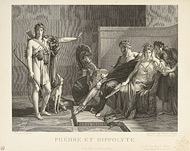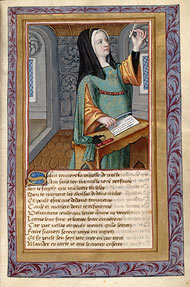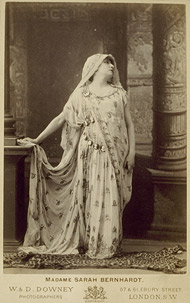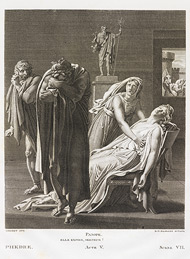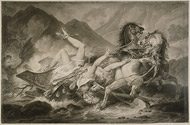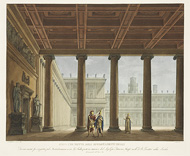| Education | ||
| Exhibitions | ||
| Explore Art | ||
| Research and Conservation | ||
| Bookstore | ||
| Games | ||
| About the J. Paul Getty Museum | ||
| Public Programs | ||
| Museum Home
|
August 24–December 4, 2006 at the Getty Villa
This exhibition illustrates the enduring allure of the ancient Greek myth of Hippolytos and Phaidra and examines how the myth has been adapted and interpreted in different periods in art, stage, and film. Psychological struggle, religious fundamentalism, and miscommunication between genders and generations are central themes of the myth, which has appealed to artists and writers for over 2,000 years. The image above mixes principal scenes from Jean Racine's 17th-century adaptation of the myth. Hippolytos's outstretched arm indicates his rejection of Phaidra and his refusal to answer the reproaches of his father, Theseus, who clenches his fist in anger. Hippolytos's rigid stance and aloof expression are offset by Phaidra's intense, agitated gaze. |
|||||||||||||
Phaidra's Passion Phaidra was the daughter of the mythical King Minos and Queen Pasiphaë of Crete, as well as the half sister of the Minotaur, a monster part man, part bull. The tragic image of Phaidra, a lovesick woman struggling with her illicit passion for Hippolytos, has inspired artists working in diverse media, from manuscripts to prints and film. |
|||||||||||||
This photograph features French actress Sarah Bernhardt, one of the most celebrated actresses of the late 19th century, playing the lead role in Phèdre by French dramatist Jean Racine. |
|||||||||||||
The Story Retold
Different writers have found new ways to tell the story of Phaidra and Hippolytos while retaining the essential spirit of Euripides' play. Roman author Seneca, for example, transformed the conflict between Hippolytos's obsessive control and Phaidra's uncontrollable passions into a political allegory. Director Jules Dassin set his 1962 film version of the myth, Phaedra, in the contemporary world of high finance and modern Greek aristocracy. |
|||||||||||||
The Death of Hippolytos Hippolytos, whose name means "loosed horse" or "undone by horses," was thrown from his chariot and dragged to his death. The dramatic moment of his death has attracted artists and illustrators from antiquity to the 20th century. |
|||||||||||||
In this spectacular Neoclassical drawing of Hippolytos's tragic fall, French painter and lithographer Carle Vernet contrasted the illuminated body of the chaste hero in the foreground with the dark winged dragon (rather than the bull of the ancient myth) in the background. |
|||||||||||||
The Story Staged The tragic myth of Hippolytos and Phaidra has been revived and reinterpreted on stage from the 1600s to the present day. Visionary directors and designers have at times fused classical and Far Eastern motifs, exploited newly discovered archaeological finds, and adapted monumental ancient architecture for the stage. |
|||||||||||||
This book cover for an adaptation of the tragedy by Gabriele D'Annunzio (Italian, 1863–1938) recalls ancient Athenian vase-painting in its use of red and black. |
|||||||||||||
|
|||||||||||||||||
